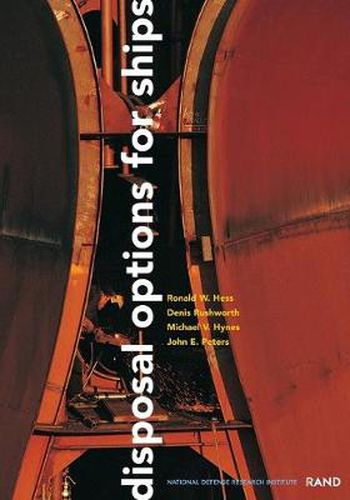Readings Newsletter
Become a Readings Member to make your shopping experience even easier.
Sign in or sign up for free!
You’re not far away from qualifying for FREE standard shipping within Australia
You’ve qualified for FREE standard shipping within Australia
The cart is loading…






This book identifies and evaluates options for the disposal of U.S. Navy and U.S. Maritime Administration (MARAD) ships. Four options are considered: long-term storage, domestic recycling, overseas recycling, and reefing (i.e., the sinking of ships to build artificial reefs). The authors examined the use of private and public U.S. shipyards, international organizations, and partnerships between U.S. and foreign companies. The study took applicable environmental and worker health and safety regulations into account to arrive at estimates of the costs, benefits, capacities, capabilities, feasibility, and risks associated with each option. It found that the Navy and MARAD should exploit the experience gained in the Navy’s ongoing Ship Disposal Program and the recently initiated MARAD program to dispose of poor-condition ships in the inventory. Such a strategy would reduce the current risk of ship sinking or other notable environmental damage., At the same time, this study also found that both agencies should initiate coordinated discussions with the Environmental Protection Agency (EPA) and other coastal regulatory authorities to develop standards for reefing that will make it a viable, long-term option for disposing of as many of the 358 ships in the current inactive fleet as possible. The Navy and MARAD should not opt for overseas recycling; such a program would involve many impediments and difficulties. Neither should they opt for long-term storage, which entails high and uncertain costs and only defers, rather than solves, the problem of disposing of the ships.
$9.00 standard shipping within Australia
FREE standard shipping within Australia for orders over $100.00
Express & International shipping calculated at checkout
This book identifies and evaluates options for the disposal of U.S. Navy and U.S. Maritime Administration (MARAD) ships. Four options are considered: long-term storage, domestic recycling, overseas recycling, and reefing (i.e., the sinking of ships to build artificial reefs). The authors examined the use of private and public U.S. shipyards, international organizations, and partnerships between U.S. and foreign companies. The study took applicable environmental and worker health and safety regulations into account to arrive at estimates of the costs, benefits, capacities, capabilities, feasibility, and risks associated with each option. It found that the Navy and MARAD should exploit the experience gained in the Navy’s ongoing Ship Disposal Program and the recently initiated MARAD program to dispose of poor-condition ships in the inventory. Such a strategy would reduce the current risk of ship sinking or other notable environmental damage., At the same time, this study also found that both agencies should initiate coordinated discussions with the Environmental Protection Agency (EPA) and other coastal regulatory authorities to develop standards for reefing that will make it a viable, long-term option for disposing of as many of the 358 ships in the current inactive fleet as possible. The Navy and MARAD should not opt for overseas recycling; such a program would involve many impediments and difficulties. Neither should they opt for long-term storage, which entails high and uncertain costs and only defers, rather than solves, the problem of disposing of the ships.